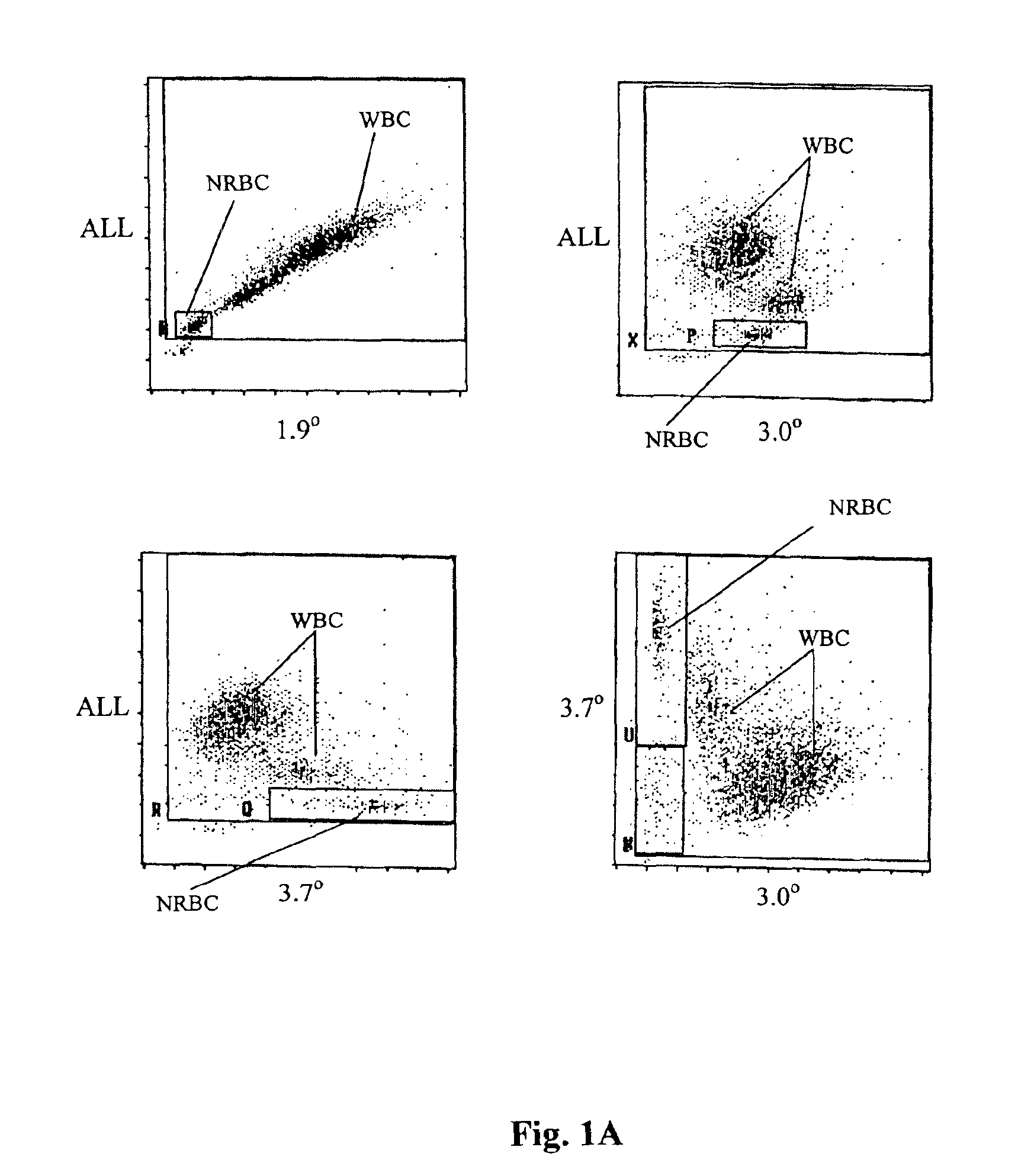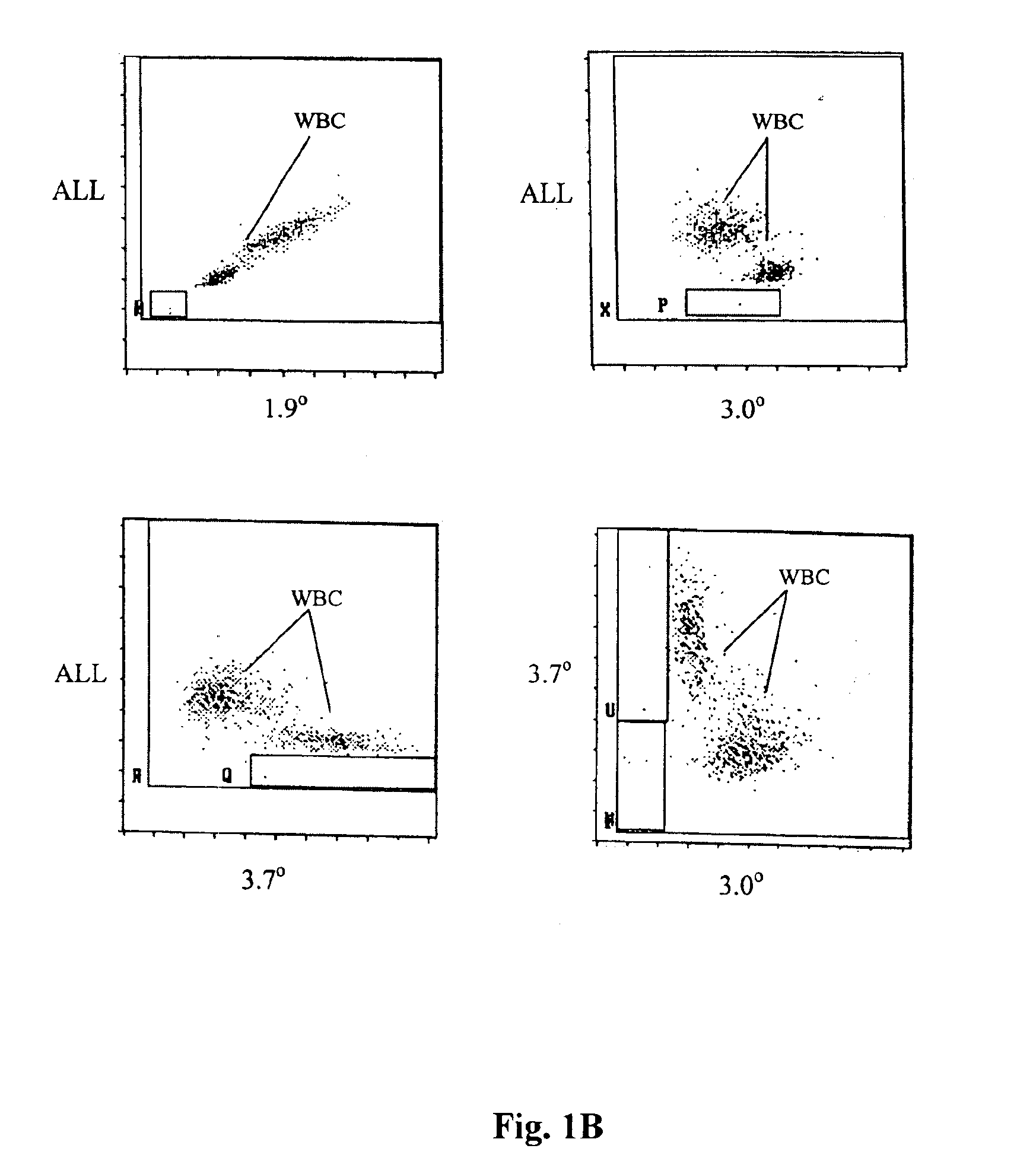Reference control for optical measurement of nucleated red blood cells of a blood sample
a nucleated red blood cell and reference control technology, applied in the direction of instruments, dead animals, chemical methods analysis, etc., can solve the problems of difficult to simulate optical properties, difficult to achieve the effect of comparing the number of samples, and complex and costly processes for manufacturing nucleated red blood cells for the reference control produ
- Summary
- Abstract
- Description
- Claims
- Application Information
AI Technical Summary
Benefits of technology
Problems solved by technology
Method used
Image
Examples
example 1
[0049]An experimental lysing reagent was prepared, which was an aqueous solution containing active components for lysing red blood cells and analysis of nucleated red blood cells: 25.0 g / L of tetradecyltrimethylammonium bromide, 15.0 g / L of Igepal SS-837 (ethoxylated phenol, from Rhone-Poulenc, Cranbury, N.J.), and 4.0 g / L Plurofac A38 prill surfactant (ethoxylated alcohol, from BASF Corp., Florham Park, N.J.).
[0050]34 μl of a whole blood sample was diluted with 850 μL of an isotonic blood diluent, Isoton® III (Beckman Coulter, Inc., Miami, Fla.), then mixed with 145 μl of the above described lytic reagent composition. The sample mixture was aspirated by an experimental flow cytometric instrument which is a modified Coulter XL™ flow cytometer (Beckman Coulter, Inc., Miami, Fla.), equipped with an optical detector enabling detection of light scatter signals at various angles including 1.9°±0.5°, 3.0°±0.5°, and 3.7°±0.5°, and axial light loss (0°±0.5°). The sample mixture was drawn th...
example 2
[0053]Two sets of polystyrene particles having a refractive index of 1.59, mean diameters of 6.44 μm and 7.22 μm, respectively, were each suspended in an aqueous solution of nonionic surfactant Tween® 20 (Polyoxyethylene sorbitan monolaureate, J T Baker, Phillipsburg, N.J.). Each particle suspension has a particle concentration from about 3.0×103 / μl to 6.0×103 / μl. Both sets of the polystyrene particles are the products of Bangs Laboratories, Inc., Fishers, Ind. These particles had a narrow size distribution with a standard deviation of the diameter about 0.07 μm.
[0054]34 μl of the particle suspension solution was diluted with 850 μl of Isoton® III, then mixed with 145 μl of the lytic reagent composition of Example 1. The sample mixture was aspirated, and measured by the experimental flow cytometric instrument described in Example 1.
[0055]FIG. 2 shows scattergrams of 6.44 μm polystyrene particles. The particles located in the corresponding NRBC regions of the human blood sample.
[0056...
example 3
[0058]Two sets of synthetic particles were each suspended in an aqueous solution of nonionic surfactant Tween® 20 to form two particle suspensions. The first set of particles was polystyrene particles having a mean diameter of 6.44 μm and a refractive index of 1.59. The second set of particles was carboxylated polystyrene particles having a mean diameter of 10.9 μm and a refractive index of 1.60. The 10.9 μm particles were dark blue. Both sets of particles are the products of Bangs Laboratories, Inc., Fishers, Ind.
[0059]A reference control composition was prepared by adding a predetermined amount of each particle suspension into an aqueous cell suspension medium (composition provided below) which contained a mixture of stabilized human red blood cells and platelet analogs made of goat red blood cells. The stabilized human red blood cells and the platelet analogs were separately suspended in analog suspension media prior to use. The analog concentrations in the reference control comp...
PUM
| Property | Measurement | Unit |
|---|---|---|
| mean particle diameter | aaaaa | aaaaa |
| refractive index | aaaaa | aaaaa |
| refractive index | aaaaa | aaaaa |
Abstract
Description
Claims
Application Information
 Login to View More
Login to View More - R&D
- Intellectual Property
- Life Sciences
- Materials
- Tech Scout
- Unparalleled Data Quality
- Higher Quality Content
- 60% Fewer Hallucinations
Browse by: Latest US Patents, China's latest patents, Technical Efficacy Thesaurus, Application Domain, Technology Topic, Popular Technical Reports.
© 2025 PatSnap. All rights reserved.Legal|Privacy policy|Modern Slavery Act Transparency Statement|Sitemap|About US| Contact US: help@patsnap.com



